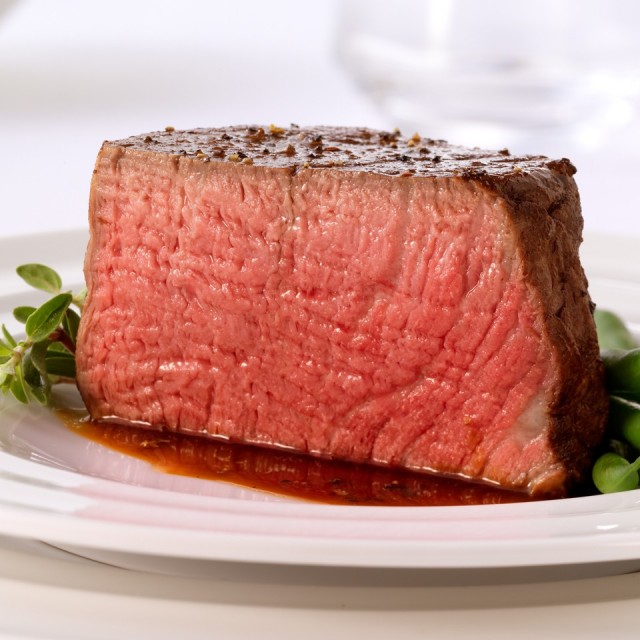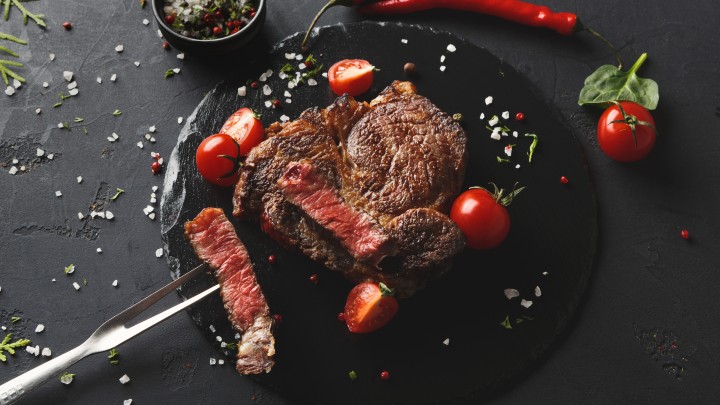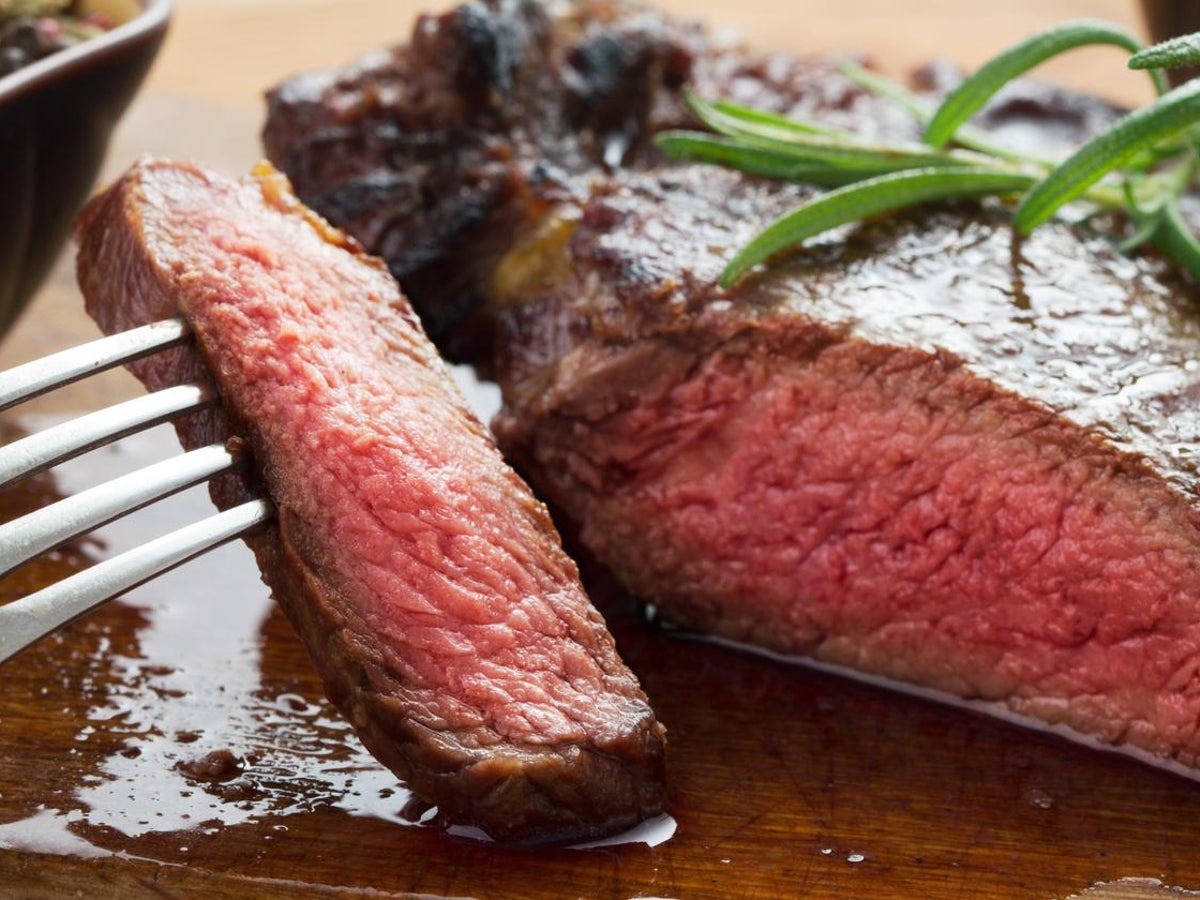
Introduction
The Misconception Of The Red Juice In Steak As Blood
Many people believe that the red juice that is often found in cooked steak is blood. However, this is actually a common misconception. In reality, the red juice in steak is not blood but rather a protein called myoglobin.
Explanation Of What The Red Juice Actually Is
The red juice that is present in steak is a result of a combination of water and myoglobin. Myoglobin is a protein that is responsible for storing oxygen in muscle cells. It gives meat its red color and is particularly concentrated in the areas of the animal’s body that contain a lot of muscle, such as the legs and back. When the meat is cooked, the myoglobin is denatured and the water is released, resulting in the red juice that is often seen on plates.
A Combination Of Water And Myoglobin
When the meat is cooked, the heat causes the myoglobin to undergo a chemical change, resulting in a red to pink color. The more myoglobin present in the muscle tissue, the redder the meat will appear. This is why meats like beef are usually redder than poultry or pork. It is important to note that properly cooked meat should have a minimal amount of red juice. This is because the meat has been properly drained and any remaining blood has been removed during the butchering process. Therefore, the red juice in a properly cooked steak is not blood but simply a combination of water and myoglobin.
In conclusion, the red juice in steak is not blood but a combination of water and myoglobin. This protein is responsible for the red coloring in meat and is released when the meat is cooked. Understanding this can help dispel the misconception that steak contains blood, making it easier for individuals to enjoy their meat without any squeamishness.
What Is Myoglobin?
Definition And Function Of Myoglobin
Myoglobin is a protein that plays an important role in muscle tissue, particularly in animals. It is responsible for storing oxygen in muscle cells, ensuring a steady supply of oxygen during physical activity. Myoglobin is a heme protein, meaning it contains a molecule of heme, which gives it a red color.
Presence Of Myoglobin In Red Meat And Its Role In Oxygen Transportation
Red meat, such as beef, contains a high concentration of myoglobin. This is why red meat appears more red compared to other types of meat like poultry or pork. The myoglobin in the meat binds with oxygen, allowing it to be transported to the muscles and providing the necessary oxygen supply for muscle activity.
As the meat is cooked, the heat causes the myoglobin to undergo a chemical change, resulting in the release of the red juice. The more myoglobin present, the redder the meat will appear. However, it is important to note that properly cooked meat should have a minimal amount of red juice. This is because the meat has been drained and any remaining blood removed during the butchering process.
Understanding myoglobin helps clarify the misconception that the red juice in steak is blood. It is actually a combination of water and denatured myoglobin. Knowing this can help individuals enjoy their steak without any mistaken notion of blood presence.
In conclusion, the red juice in steak is not blood but a combination of water and myoglobin. Myoglobin is a protein responsible for storing oxygen in muscle cells and gives meat its red color. The release of this red juice during cooking is a result of the denaturation of myoglobin. By understanding the composition of the red juice in steak, individuals can appreciate their meal without any confusion or squeamishness.
Aging Process And Meat Juice
The aging process of meat plays a significant role in the presence of red juice in steak. As meat ages, the muscle tissue begins to break down, leading to the release of liquid and myoglobin.
Breakdown Of Muscle Tissue As Meat Ages
During the aging process, the muscle tissue of the meat slowly starts to break down. This breakdown is a natural occurrence and is influenced by various factors such as temperature, humidity, and enzymes present in the meat. As the muscle tissue breaks down, it becomes more tender and develops a more enhanced flavor.
Leak Of Liquid And Myoglobin Due To Muscle Tissue Breakdown
As the muscle tissue breaks down, it can cause the release of liquid and myoglobin from the meat. This liquid, also known as purge, appears as a reddish juice. It is important to note that this red juice is not blood, as commonly misconceived. Instead, it is a combination of water and denatured myoglobin.
The presence of myoglobin in red meat is what gives it its characteristic red color. Myoglobin is a protein responsible for storing oxygen in muscle cells, ensuring an adequate oxygen supply during physical activity. The myoglobin binds with oxygen and transports it to the muscles, contributing to the red appearance of the meat.
It is essential to understand that properly cooked meat should have a minimal amount of red juice. Before cooking, the meat is typically drained, and any remaining blood is removed during the butchering process. The red juice that emerges during cooking is a result of the denaturation of myoglobin due to the heat.
In conclusion, the red juice in steak is a combination of water and denatured myoglobin, not blood. The breakdown of muscle tissue during the aging process leads to the release of liquid and myoglobin, giving the meat its reddish appearance. Understanding the science behind the red juice in steak allows for a more accurate appreciation of the meat without any confusion.

The Role Of Water
Importance Of Water In The Red Juice Of Steak
Water is an essential component of the red juice in steak. It contributes to the juiciness and tenderness of the meat, enhancing the overall eating experience. The presence of water in the red juice helps to keep the steak moist during cooking and prevents it from drying out.
How Water Mixes With Myoglobin To Create The Red Juice
When the muscle tissue in the steak breaks down, it releases myoglobin, a protein responsible for storing oxygen in muscle cells. Myoglobin has a reddish color, and when it comes into contact with water, it creates the red juice that is often seen in cooked steak.
The process of water mixing with myoglobin occurs as the meat is cooked. The heat applied during cooking denatures the myoglobin, causing it to change its structure and releasing a reddish liquid. This liquid then combines with the water present in the meat, resulting in the familiar red juice.
The interaction between water and myoglobin is crucial in determining the juiciness and color of the steak. The more water present in the meat, the juicier and more tender the steak will be. Additionally, the amount of myoglobin released and mixed with water also affects the intensity of the red color seen in the juice.
Understanding the role of water in the creation of the red juice helps to explain why properly cooked steak should have a minimal amount of this juice. It is a result of the natural breakdown of muscle tissue during the aging process and the denaturation of myoglobin due to cooking.
In conclusion, water plays a significant role in the red juice of steak. It contributes to the juiciness and moistness of the meat, while also interacting with myoglobin to create the characteristic red color. Appreciating the role of water in the red juice adds to our understanding and enjoyment of a perfectly cooked steak.
Common Misconceptions
Debunking The Belief That The Red Juice Is Blood
Contrary to popular belief, the red juice that is often seen in a steak is not blood. Many people associate the red color with blood, assuming that it is a sign of raw or undercooked meat. However, this is far from the truth.
The red juice in a steak is primarily composed of a protein called myoglobin. Myoglobin is responsible for storing oxygen in muscle cells and has a reddish color. When the muscle tissue breaks down during cooking, myoglobin is released and mixes with water, resulting in the familiar red juice.
Explaining The Presence Of Myoglobin And Water In The Meat
Myoglobin is naturally present in red meat and is more abundant in muscles that are used for movement, such as those found in a steak. It helps to supply oxygen to the muscles during activity, giving them the energy they need.
Water, on the other hand, is an essential component of muscle tissue. It contributes to the juiciness and tenderness of the meat, enhancing the overall eating experience. The presence of water in the red juice helps to keep the steak moist during cooking and prevents it from drying out.
When the steak is cooked, the heat denatures the myoglobin and causes it to change its structure, releasing a reddish liquid. This liquid then combines with the water present in the meat, resulting in the red juice that is visible when the steak is cut into.
The amount of red juice in a steak can also provide clues about its level of doneness. A steak that is cooked to medium-rare or medium will have a pink or slightly red center, indicating that the myoglobin has been properly cooked but still retains some of its color. If the juice is clear or slightly pink, the steak is likely to be well-done, with the myoglobin fully cooked and no longer contributing to the red color.
Understanding the true nature of the red juice in a steak dispels misconceptions and allows us to appreciate the role of myoglobin and water in creating the delectable flavors and textures that we love in a perfectly cooked steak.
Health And Safety Considerations
Assurance Of The Safety Of The Red Juice In Steak
Contrary to popular belief, the red juice in a steak is not blood and poses no health risks when consumed. The protein myoglobin, which gives the juice its red color, is safe for consumption as it is a natural component of muscle tissue. It does not contain any harmful pathogens or bacteria.
Importance Of Properly Cooking Meat To Eliminate Any Potential Risks
While the red juice in a steak is safe to consume, it is important to ensure that the meat is cooked properly to eliminate any potential risks. Cooking the steak to the appropriate internal temperature ensures that any harmful bacteria, such as E. coli or Salmonella, are killed.
Properly cooking the steak to the recommended temperature helps guarantee food safety and minimize the risk of foodborne illnesses. The internal temperature for a medium-rare steak should reach 130°F (54°C), while a medium steak should reach 140°F (60°C). For well-done steaks, an internal temperature of 160°F (71°C) is recommended.
Using a meat thermometer is an effective way to monitor the internal temperature and ensure that the steak is cooked to the desired level of doneness. It is also important to allow the steak to rest for a few minutes before cutting into it. This allows the juices to redistribute, resulting in a juicier and more flavorful steak.
In conclusion, understanding the nature of the red juice in a steak dispels misconceptions and allows us to appreciate the role of myoglobin and water in creating the flavors and textures we enjoy. By following proper cooking techniques and ensuring that the meat reaches the appropriate internal temperature, we can safely enjoy a delicious and perfectly cooked steak.

Culinary Implications
Significance Of The Red Juice In Terms Of Flavor And Juiciness
The red juice in a steak plays a crucial role in enhancing its flavor and juiciness. The protein myoglobin, which gives the juice its red color, contributes to the rich and savory taste of a well-cooked steak. Myoglobin also helps the meat stay moist, resulting in a succulent and tender texture.
How Chefs And Restaurants Utilize The Red Juice For Cooking And Presentation
Chefs and restaurants understand the importance of the red juice in steak and use it to elevate their dishes. Here are some common ways they utilize the red juice:
- Basting: When cooking a steak, some chefs use the red juice to baste the meat, enhancing its flavor and moisture content. Basting helps to infuse the steak with additional juices during the cooking process, resulting in a more flavorful and succulent end product.
- Plating and Presentation: The red juice adds a vibrant and appetizing element to the presentation of a steak dish. It is often drizzled on the plate or used as a natural sauce to enhance the visual appeal of the dish. This visually appealing red juice adds an appetizing touch and indicates the juiciness of the steak.
- Au Jus: Au jus, meaning “with juice” in French, is a type of sauce made from the red juice of meat. Chefs often serve au jus as a dipping sauce or pour it over the steak to add an extra layer of flavor. The au jus enhances the natural flavors of the steak and provides a delightful element to each bite.
- Reducing and Deglazing: The red juice can be reduced or deglazed in a pan to create flavorful sauces or gravies. This process enhances the concentrated flavors of the juice, making it a versatile ingredient for various steak preparations.
In conclusion, the red juice in a steak not only adds to its flavor and juiciness but also serves as a valuable component in culinary techniques. Chefs and restaurants utilize this red juice creatively to enhance the cooking process and presentation of steak dishes, resulting in an enjoyable dining experience for steak lovers.
Variations In Red Juice
Different Levels Of Red Juice In Various Cuts Of Meat
The amount of red juice present in a steak can vary depending on the cut of meat. Some cuts, such as ribeye or New York strip, are known to produce more red juice compared to leaner cuts like filet mignon. The marbling and fat content in these cuts contribute to the production of more red juice during cooking. The higher fat content allows for a richer and juicier eating experience.
Factors Affecting The Amount Of Red Juice Produced In Steak
Several factors can influence the amount of red juice produced in a steak. These factors include:
- Cooking Temperature: The cooking temperature plays a significant role in the amount of red juice present in a steak. Higher cooking temperatures, such as grilling or searing at high heat, can lead to more red juice being released from the meat. This is because the heat causes the proteins in the meat to denature and release their juices.
- Doneness Level: The doneness level of a steak can also impact the amount of red juice produced. A rare or medium-rare steak is likely to have more red juice compared to a well-done steak. This is because cooking the steak for a longer time at higher temperatures causes more moisture to be evaporated, resulting in a reduced amount of red juice.
- Resting Period: Allowing a cooked steak to rest before cutting into it can affect the amount of red juice that flows out. Resting the steak allows the juices to redistribute and be absorbed back into the meat, resulting in a juicier steak when sliced.
- Quality and Age of the Meat: The quality and age of the meat can also influence the amount of red juice produced. Younger and higher-quality cuts of meat tend to have more myoglobin and fat content, leading to a greater amount of red juice during cooking.
Understanding these variations and factors can help chefs and home cooks adjust their cooking techniques to achieve the desired amount of red juice in their steaks.
Conclusion
Recap Of The Truth About The Red Juice In Steak
In summary, the red juice present in a steak is not blood, but rather a protein called myoglobin. This red juice is primarily composed of myoglobin, along with some fat and water. It adds flavor and juiciness to the steak, enhancing the overall eating experience.
Appreciating The Science Behind Meat Juices And Dispelling Misconceptions
Understanding the science behind meat juices can help debunk misconceptions and appreciate the intricate process of cooking a steak. The variations in red juice levels in different cuts of meat, the factors that influence the amount of juice produced, and the importance of resting the steak before cutting into it all play a part in achieving the desired juiciness and flavor.
By cooking at different temperatures and adjusting the doneness level, chefs and home cooks can control the amount of red juice in their steaks. It’s fascinating to know that the quality and age of the meat also contribute to the amount of juice produced.
Next time you enjoy a juicy steak and see the red juice, remember that it’s not blood, but rather a protein-rich liquid that enhances the flavor and tenderness of the meat. Appreciate the science behind it and experiment with different cooking techniques to achieve the perfect steak every time.
In conclusion, the red juice in steak is not blood, but a protein called myoglobin. Understanding the science and factors that contribute to the amount of red juice can help elevate your cooking skills and appreciation for a perfectly juicy steak.
FAQ: Understanding Meat Juices – What’s the Red Juice in Steak?
Q: What is the red juice in steak?
A: The red juice commonly found in steak is not actually juice, but rather a mixture of water, protein, and a pigment called myoglobin.
Q: What is myoglobin?
A: Myoglobin is a protein found in muscle cells. It binds with oxygen and gives meat its red color. When meat is cooked, myoglobin undergoes chemical changes, resulting in varying shades of pink or brown.
Q: Is the red juice in steak blood?
A: Contrary to popular belief, the red juice in steak is not blood. The blood is mostly removed during the slaughter and processing of the animal, leaving only traces behind. The red color in steak comes from myoglobin, not blood.
Q: Why does the color of the juice change when cooking steak?
A: As the temperature rises during cooking, the myoglobin in the meat undergoes changes. At lower temperatures, myoglobin remains pink, resulting in a red or pink juice. However, as the steak cooks further, the myoglobin loses its ability to bind oxygen, leading to a change in color from pink to brownish.
Q: Is it safe to consume the red juice in steak?
A: Yes, it is safe to consume the red juice found in properly cooked steak. However, it is important to ensure that the meat is cooked to the proper internal temperature to eliminate any potential harmful bacteria or pathogens.
Q: Does the amount of red juice indicate the doneness of the steak?
A: The amount of red juice or pinkness in the meat is not a reliable indicator of doneness. Instead, it is best to rely on a meat thermometer to check the internal temperature and determine whether the steak is cooked to your desired level of doneness.
Q: Can the red juice be used to make sauces or gravies?
A: The red juice from steak is packed with flavor and can be used to make delicious sauces or gravies. However, it is important to strain and reduce the juice before using it in recipes to ensure that any impurities are removed.
Q: How can I retain the juices in my steak?
A: To retain the natural juices in your steak, it is best to avoid overcooking. Overcooking causes the muscle fibers to contract and the juices to be squeezed out, resulting in a drier steak. Use proper cooking techniques and allow the steak to rest after cooking to help the juices redistribute and create a more flavorful result.
Q: Are there any health benefits to consuming the red juice in steak?
A: The red juice in steak is a good source of protein and various nutrients like iron, zinc, and B vitamins. However, it is important to consume steak in moderation as part of a balanced diet and to choose lean cuts of meat to minimize saturated fat intake.

Tropical Blendz Café and Juice Bar is a safe and clean environment where we provide immune-boosting natural juices, smoothies, shakes, authentic Caribbean cultural foods, and much more. Our juices are made from all-natural, unique fruits, vegetables, and herbs.